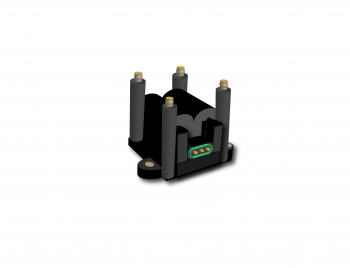
PicoScope 7 Automotive
Available for Windows, Mac, and Linux, the next evolution of our diagnostic scope software is now available.

Multimeter Probes

10:1 Attenuator
*At Pico we are always looking to improve our products. The tools used in this guided test may have been superseded and the products above are our latest versions used to diagnose the fault documented in this case study.
The purpose of this test is to examine the characteristics of the primary ignition waveform from within the DIS unit.
WARNING
This test involves measuring a potentially hazardous voltage.
Please ensure you follow manufacturers' safety instructions and working practices and ensure the rated voltage for all accessories you are using meets or exceeds the expected voltage.
View connection guidance notes.
Note
If you are using a 20:1 attenuator please adjust the Probe settings for the relevant channel. These settings can be found under the Channel Options button, then: Probe > 20:1 Attenuator.
This known good example shows a typical primary waveform.

The ignition primary waveform is measuring the negative side of the ignition coil. The earth path of the coil can produce over 350 volts.
Within the primary picture there are several sections that need closer examination. In the waveform shown, the horizontal voltage line at the centre of the oscilloscope begins fairly constant at about 40 volts, but then drops sharply into what is referred to as the coil oscillation.
There is no current in the coil's primary circuit until the dwell period which is when the coil is earthed and the measured voltage drops to zero. The dwell period is controlled by the ignition amplifier, and the length of the dwell is determined by the time it takes to build up the requisite 5-10 amps (depending on system). When this predetermined current has been reached, the amplifier stops increasing the primary current and maintains it until the earth is removed from the coil, at the precise moment of ignition.
The vertical line at the centre of the trace, called the 'induced voltage', is above 200 volts. The induced voltage is produced by a process called magnetic induction. At the point of ignition, the coil's earth circuit is removed and the magnetic field or flux collapses across the coil's windings. This in turn induces an average voltage between 150 to 350 volts. The coil's High Tension (HT) output is proportional to the induced voltage. The height of the induced voltage is sometimes referred to as the primary peak volts.
GT396
Disclaimer
This help topic is subject to changes without notification. The information within is carefully checked and considered to be correct. This information is an example of our investigations and findings and is not a definitive procedure.
Pico Technology accepts no responsibility for inaccuracies. Each vehicle may be different and require unique test
settings.
We know that our PicoScope users are clever and creative and we’d love to receive your ideas for improvement on this test. Click the Add comment button to leave your feedback.